|
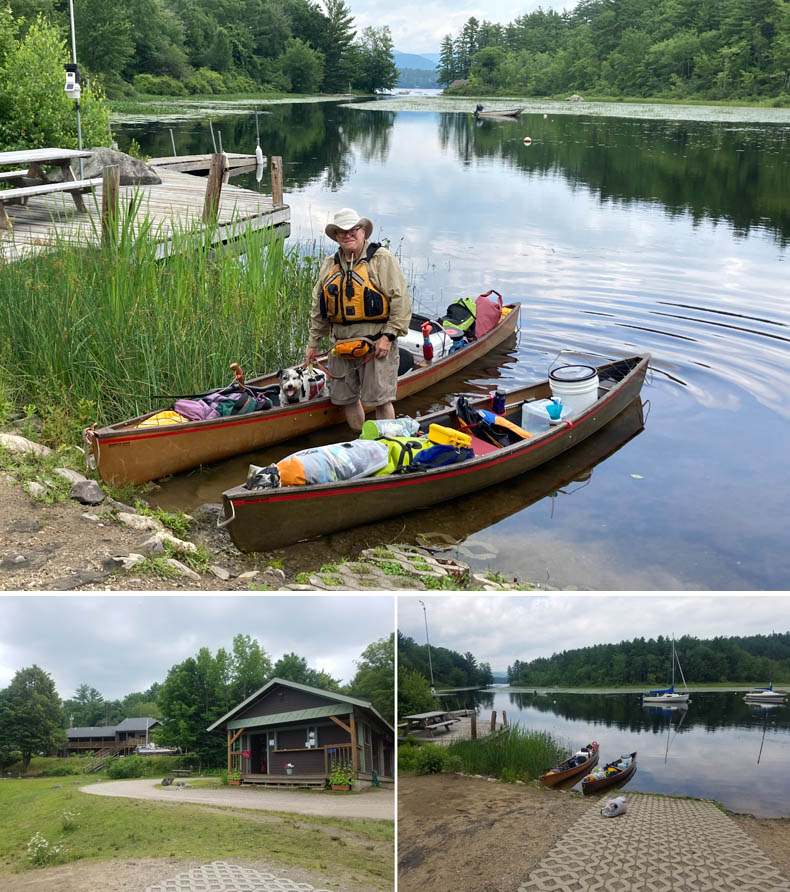
Top: David and Millie are loaded and ready to .
Bottom: The SLA main building, rental shack, and small boat launch ramp in Piper Cove.
SUMMER ON SQUAM LAKE
Story by Tamsin Venn. Photos by Tamsin Venn and David Eden
For a long time, we have reported on the Lakes of October, where one can paddle through firey reflective displays of shoreside foliage. Days are bright blue (but not always), water is cold, boats are few, nights are chilly, campfires welcome, and straggling migrating birds pass overhead. Winter is coming.
We decided to switch it up and try one of these lakes in the middle of summer to see what we were missing. Thus we arrived on Squam Lake, Holderness, N.H., the first week of July. To secure this campsite on Bowman Island, I joined the Squam Lakes Assn. (SLA) and signed up for a lottery in January.
We were last on Squam in September, 2020 (see ACK October 2020) when Covid-19 still held us all tightly in its grip and drove us into lockdown. How great it was to experience the freedom of paddling and camping here on Squam. Back then, when we arrived at the SLA docks in Holderness, no one was there, the building was locked tight, all communication was done by email, and an answering machine picked up the phone. It was otherworldly. We printed and pasted together our own map because the store was closed. The outhouse had a combination lock (perish the thought if you forget the number). The free firewood bundles, one per night, were neatly stacked near the landing on Bowman. You could buy more through a Quark code on your phone. The only other party on the island was someone we actually knew.

On the crossing to Bowman Island. That's not a mega-martini in Tammy's hand. It's Millie's water bottle.
Fast forward ten months with a change of scene, brought on by both relaxation of restrictions plus summer activity. Many people of all ages were milling around at the SLA center on the mainland at Piper Cove, those launching in kayaks, or returning in canoes, AmeriCorps volunteers busy with gear and digging a garden, an outdoor meeting under a tent, kids, dogs, campers, life.
Furthermore, this was the first time ever I have launched here and the lake wasn't ripping up outside the protection of Piper Cove.
People make a big difference. You could chat and share plans, weather, ask questions. Heck, we could ditch the kayaks and rent a sailboat. SLA also maintains a rental fleet of various human-powered craft.
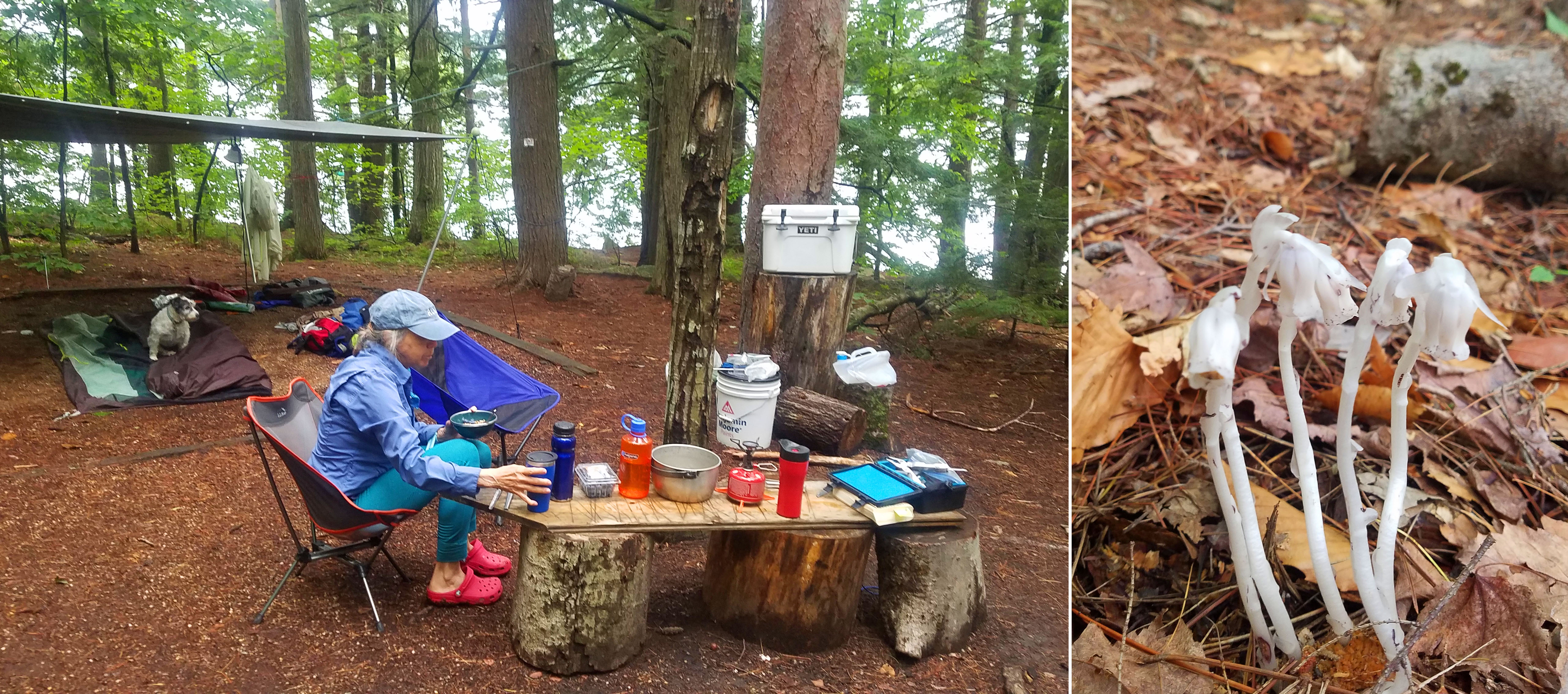
L: Campsite #3 on Bowman. R: Some Indian pipe near our tent.
The true gems for kayakers are two islands, Bowman and Moon, where you can camp on this almost entirely privately-owned shoreline. You can also camp at Chamberlain-Reynolds Forest on the mainland, just down from HQ, which requires you to paddle to, or pack in for a mile. The more I get to know Squam Lakes Assn., the more I feel grateful as a paddler that it exists. Its non-profit mission from its founding in 1904-05 is the lake's protection, from pollution, invasive species, and other dangers, as well as water level maintenance, boat safety, and maintaining navigation aids.
We opted for Bowman because it allows dogs. Bowman 3 was just about the most perfect site ever, three gravel tent sites, leveled off in a roomy area, under the shade of tall deciduous and pine trees, the lake framed beyond, and accessible by a perimeter trail. It is also closest to Sunset Rock, a sun-warmed granite shelf with front row seat to sunset over the Sandwich Range. Last September from here, we watched an ethereal sunset, the sun clouded by smoke from western wildfires. This year, we watched a drama queen thunderstorm roll by in the unsettled weather riding on the front of tropical storm Elsa, gathering force in Florida.
Who is familiar with this scenario? You make a reservation in January and two days before departure seven months later, we debate canceling the trip because of the approach of a tropical storm. The weather report was abysmal, letting us know we could count on rain, then steady rain, scattered thunderstorms, lightning, and hazardous weather, over a three-day period, not good with an open-lake crossing at stake. On needs to be a real weather student to venture out confidently. When we got there, the nice young woman manning the info center, told me brightly that there was 19 percent chance of rain today, Tuesday, and tomorrow. It started out sunny for two days, then partly sunny the third, with winds varying form nearly calm to 10 to 15 mph, although it did pour and blow harder at night.
So much boating goes on at Squam that you are pulled into the spirit. On the day predicting T-storms, we saw a line of canoes and kayaks making their way along Long Island back to Piper Cove, as well as a mom and her daughter out kayaking and swimming to a rock (a favorite pastime), commenting on the unexpected wind. I had this fantasy that no one paddling listens to a weather radio. They are just on their summer vacations and it is Brigadoon.

What turned out a non-thunder/non-rain front looms. Millie enjoys the view from Sunset Ledge while a pod of paddlers races ahead of the threatening sky.
The motorboats are a different matter. They can cheat. That includes the two other groups of campers we shared with Bowman. Things get bad, they just hop in their motorboats and head for shore at 60 mph. We had to keep calculating wind force, direction, and waves. We finally bailed on day three, Thursday, after hearing the forecast of east winds of 20 mph with higher gusts and torrential rain for Friday, no fun when taking down camp and paddling boats crammed with gear over the open lake. This forecast, at least, was spot on, as we found out the next morning.
But ah, Squam in summer.
To preserve the islands from erosion and general human trampling, and flora and fauna disturbance, SLA's campsites are both spaced out and spacious, so you maintain a sense of privacy. Day trippers come and go during the day, but at night, this glorious island preserve is yours as well as the private serenade of loons' night calls.
We opted for a trip to the south, a 5.5-mile circuit from Bowman crossing to the passage between Kimball Island and Center Harbor Neck, then south in Sturtevant Bay past Owl's Head, south to the Squam Lake Canal that cuts the peninsula of High Haith by the Center Harbor town beach, and through the canal to Bean Cove. To get through the canal, the lake level has to be 260 feet. It was at 262 feet and it was quite clear that the level would have to be several feet higher before any sort of power boat could get through. It was a bit of a sticky moment, pushing through the water weeds that choked the channel and not sure if we would make it out the other side.

It was a bit of a struggle getting through the thick growth of water weeds and reeds that clog the canal, which turns High Haith from a peninsula into Squam's largest island.
From Bean Cove, we paddled northwest up Moultonboro Bay to the tip of High Haith between Great Island and Center Harbor Neck. Originally, we planned to cross from High Haith to the south shore of Long Island, paddle along until we were north of the Three Sisters, south along their east coasts, and so back to Bowman. Because of rising winds and very choppy conditions, we opted to paddle straight back from the northern tip of High Heath to Kimball Point and then over to Moon to our favorite cove on its northeast corner, rich in wildlife, and with a human-made floating loon nest (empty this year). We got tossed around quite a bit on the north end of Kimball Point, but our Hornbecks handled the conditions quite well.
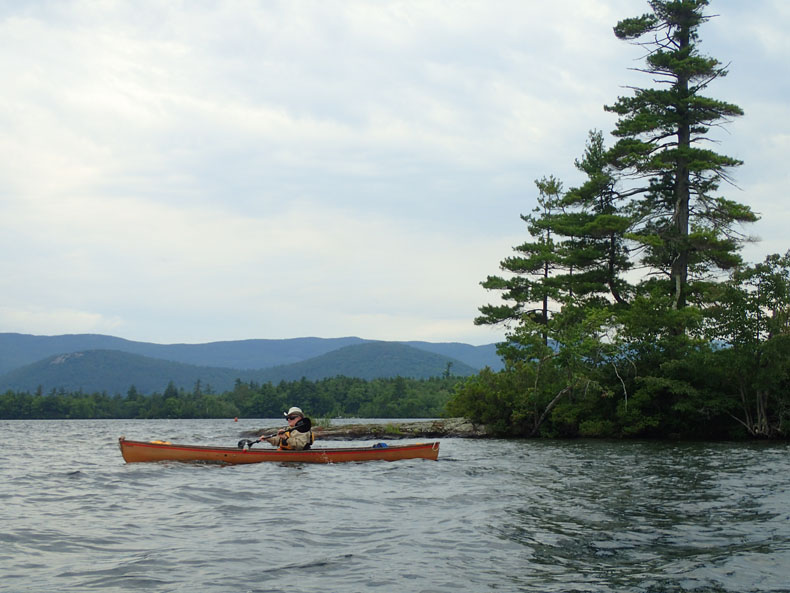
Starting the crossing from the northern tip of High Haith to Kimball Island.
In our recent meanderings, that just leaves the territory around Rattlesnake/Bear, and Squaw Cove to explore. One popular trip from Bowman is to cross over to Five Finger Point run by the University of New Hampshire and hike Rattlesnake, big bang for the buck, a short steep trail up to one of the best views in New Hampshire overlooking the lake.
Loons were around, but we saw no families, the chicks are hatched and growing by July and being fed mashed up minnows by their parents.
Last September, we caught sight several times of a single parent (probably a female, as the males leave first) still feeding the subadult before flying south.

This lovely little cove on the northeast corner of Moon Island has a man-made loon nest which has been used in previous years. Last September there was a floating sign near the entrance warning about loon chicks in the area. Not this year, alas.
How will the loon season be? You just don't know, says Harry Vogel, Senior Biologist for the Loon Preservation Committee, which monitors New Hampshire's loons. The first week in July some are still nesting, some chicks have already hatched, he notes. The population sustainability for New Hampshire lakes is ½ chick per pair, says Vogel who likes to reassure loon lovers that with millions of years of existence behind them, loons are doing something right.
The loons' biggest threat here is getting lead poisoning by swallowing lead sinkers that have detached from fishing lines. They typically eat small pebbles to help grind up food like bones and can't distinguish the sinkers from pebbles. Another major threat, and this is where kayakers come in, is being frightened off their nests. Loons can stand and balance but can barely walk (their diving power is concentrated in webbed feet at the back of their bodies making them scootch on their bellies on land). They build nests right at the shoreline. That makes them susceptible to varying lake depths, motorboat wakes, and paddlers or other boaters who scare them off the nest, leaving eggs vulnerable to heat and predators such as raccoons and gulls, not to mention the parent accidentally kicking the egg into the water.
If the loon leaves the nest, you should leave. It will come back within a half hour or so, according to Vogel. While the chicks are precocial, able to swim and feed themselves shortly after birth, most paddlers know that the small dark fuzzballs will not turn down a ride on either parents' back to warm up or rest.
Bottom line: If your presence makes it change behavior, you are too close.
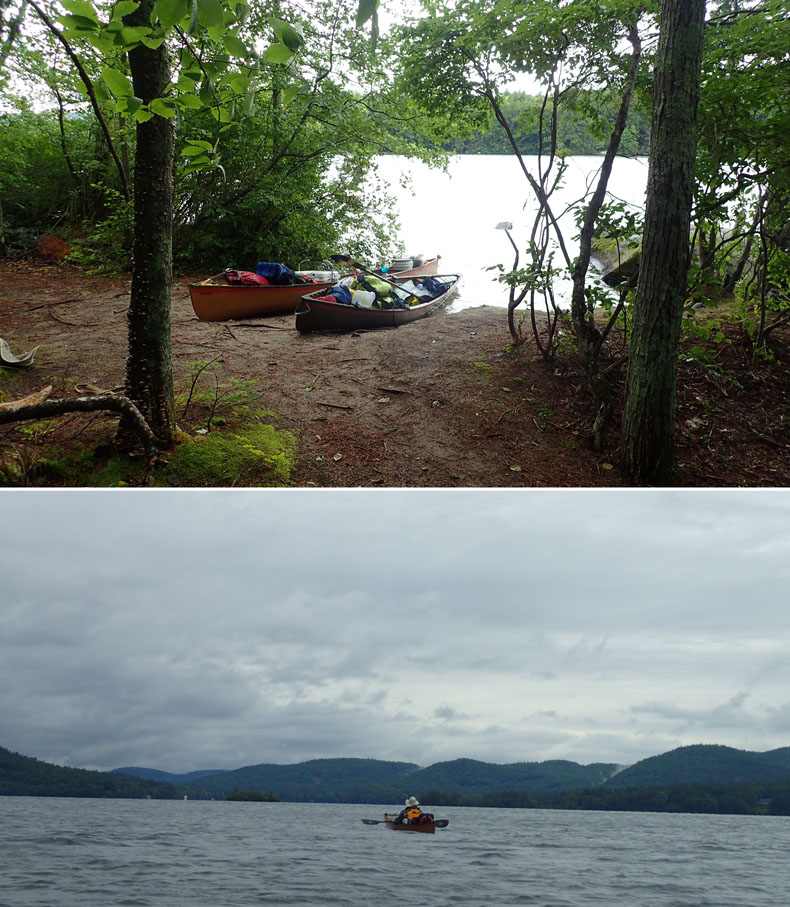
Packed to go and paddling back to SLA ahead of the heavy rain and severe thunderstorms predicted. At some point. Any minute now.
The other major difference from Lakes of October and Lakes of July are children out of school. We saw small campers paddling or hiking with youthful counselors, and several young children camped on Bowman with their parents, one group from Brooklyn and Connecticut. These are our future protectors of this special landscape, and I felt grateful this appreciation of New Hampshire forests on lake islands was being passed on, as well as the value and enjoyment of just paddling around a lake in summer.
To join SLA, go here: squamlakes.org.
SOME USEFUL MAPS
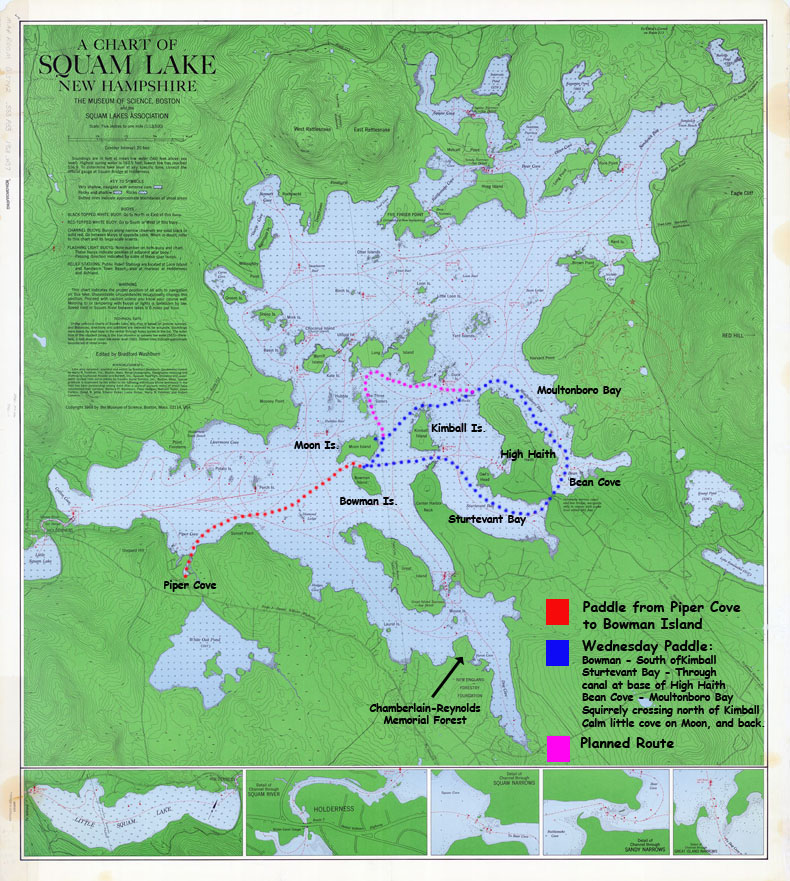
Adapted from Bradford Washburn's map of Squam Lake.

|












